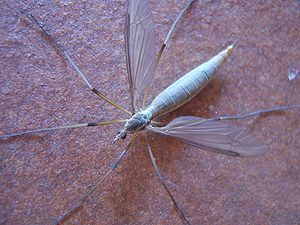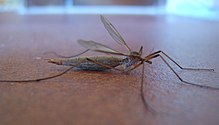Cabbage Schnake
| Cabbage Schnake | ||||||||||||
|---|---|---|---|---|---|---|---|---|---|---|---|---|

Cabbage Schnake ( Tipula oleracea ) |
||||||||||||
| Systematics | ||||||||||||
|
||||||||||||
| Scientific name | ||||||||||||
| Tipula oleracea | ||||||||||||
| Linnaeus , 1758 |
The cabbage schnake ( Tipula oleracea ) belongs like all gnats to the order of the two-winged birds . Tipula oleracea is the type species of the genus Tipula .
features
This Schnake is up to 26 millimeters long. It has a dark striped back shield, its wings have a brick-red front edge. The abdomen is gray to ocher yellow. The cabbage schnake has very long hind legs. Like all species of the subfamily Tipulinae, it has 13 antenna segments.
The sexes can be distinguished externally by the structure of the abdomen. The males have a clear, club-shaped thickening at the rear end, the hypopygium, the females have a tapering laying tube.
It does not sting because, like all gnats, it has no sting and no stinging-sucking mouth parts like other mosquito species .
distribution
The cabbage schnake is mainly found in Europe . Its distribution area extends in the south to North Africa , but has a limit in Algeria in the east , and in Europe the south-eastern limit is in Greece . It occurs in a subspecies on some Greek islands such as Crete and can also be found on Malta . It is common in Northern Europe with the exception of Finland and Latvia .
It was likely introduced as a neozoon in North and South America . Their distribution area is in the west of the North American continent between British Columbia and California , in the east between Michigan and New York . In South America it was introduced in Ecuador .
Life cycle
It flies in early summer from April to June and in a second generation in late summer from August to October. Small swarms form in the evening hours, which are probably used to form pairs. They fly over meadows and fields close to the ground.
Cabbage snakes lay their eggs one by one in loose, moist soil. Moist meadows offer them this opportunity, but gardens and cultivated areas are also ideal for laying eggs. Since a female can lay up to 1200 eggs and often up to 400 larvae per square meter live in the ground, the cabbage flies can damage the cultures in case of mass infestation.
The eggs are oval and a little less than a millimeter in size. They are dark in color. The larvae hatch after about 15 days. The larvae are brownish and initially three to four millimeters long.
The larvae feed on decaying plant matter, but also on tender roots and can damage crops such as cabbage. At night they can attack the above-ground parts of the plants and eat the leaves. The larval development takes around four months and includes four moults. The larva becomes several centimeters large and then pupates in the ground. The second generation winters in the ground until late spring or early summer.
The adult animals can be enjoyed for their soft mouth parts only liquid food such as nectar.
The entire life cycle of the cabbage schnaken is up to eight months.

